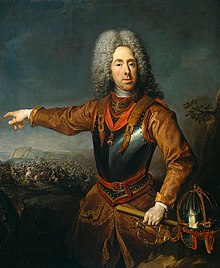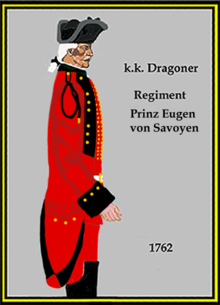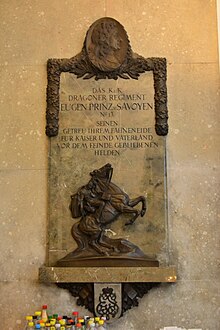kuk Dragoon Regiment "Eugene Prince of Savoy" No. 13
The regiment was established in 1682 as the Kueffstein Dragoon Regiment for the Imperial Habsburg army . From this, the kuk dragoon regiment "Eugene Prince of Savoy" No. 13 developed in the course of time up to the joint army within the Austro-Hungarian land forces
In 1769 the regiment was given the designation Cavalry Regiment No. 9 in the newly established cavalry ranking list . However, the name continued to be after the regiment owner (who did not also have to be the commander) until 1798 . There was no binding regulation of the spelling. (For example the Count Serbelloni regiment - or the Serbelloni regiment.) With each change of ownership, the regiment concerned changed its name.
After the system was changed in 1798, the numbered designation prevailed, which could possibly be linked to the name of the owner. At first the name was changed to Dragoon Regiment (light) No. 15 .
Since 1895 the regiment had to use its name "for ever".
Disregarded names were deleted without replacement in 1915. From then on, the regiment was only called kuk Dragoon Regiment No. 13 (This could not be enforced in practice, on the one hand because no one adhered to it, on the other hand because the very economical kuk military administration had ordered that all forms and stamps that were still available first be used up! )
Associations with the same name
- 1792-1802 led the later Hussar Regiment No. 16, the designation Dragoon Regiment No. 13
Formation history
- 1682 With a patent by Emperor Leopold I. Colonel began Count Hans Heinrich von Kuefstein on February 7 in Silesia one with the installation Dragoon - Regiment . To this end, 100 horsemen from the dissolved Arco Free Company were transferred to him
- 1683 A company had to the newly formed Dragoons Julius Savoy be submitted
- 1689 A Dragoons Frei company set up by Lieutenant Field Marshal Max Starhemberg was assigned to Philippsburg .
- 1694 Approximately 250 men of the former Electoral Mainz Dragoon Regiment Leiningen , which was taken over in imperial service .
- 1700 parts of the Dragoon Regiment Glöckelsperg and four companies of the Dragoon Regiment Uhlefeld incorporated
- 1721, the regiment was a company of the dissolved Dragoons Battee increased
- 1731 Parts of the auction company set up in 1727 are given to the regiments Westerloo (No. 14) and Jörger
- 1768 Grenadier was company to the newly formed first Carabinier Regiment (later Dragoons. 3 given), while a squadron of the disbanded regiment of dragoons Althann assigned
- 1769 Allocation of the cavalry ranking number 9
- 1798 Conversion to Light Dragoon Regiment No. 15
- 1802 Allocation of the majors division of the disbanded Dragoon Regiment Coburg . Renamed to Light Dragoon Regiment No. 5
- 1860 Renamed to Light Dragoon Regiment No. 1
- 1867 Renamed to Dragoon Regiment No. 13
Supplementary districts
- 1781 from Upper and Lower Austria
- 1830 from Bohemia
- 1853 From the supplementary district of Infantry Regiment No. 28 ( Prague )
- 1857–1860 from the supplementary districts of infantry regiments No. 18, 21, 36 and 42 ( Königgrätz , Tschaslau , Jung-Bunzlau , Theresienstadt )
- 1860–1868 From the supplementary districts of infantry regiments No. 18, 21, 36, 42, 73 and 74 (Königgrätz, Tschaslau, Jung-Bunzlau, Theresienstadt, Eger and Jičín )
- 1868–1880 From the supplementary districts of infantry regiments No. 36 and 42
- 1880–1889 From the supplementary districts of infantry regiments No. 36 and 74.
- In 1889 the reg. With the addition to the area of the IX. Corps (Military Territorial District Josephstadt ) assigned.
Peace garrisons
| I. | II. | III. |
|---|---|---|
|
|
|
Regimental owner
- 1682 Colonel Hans Heinrich Graf von Kueffstein (Dragoon Regiment Kueffstein)
- 1683–1736 Lieutenant General Eugen Franz Prince of Savoy , Count of Soissons (Dragoon Regiment Prince of Savoy) The regiment did not change its name until 1798
- 1737 Generalfeldwachtmeister Ferdinand Karl Graf von Aspremont-Lynden
- 1773 Major General Carl Graf Richecourt and Ney
- 1781 Major General Ferdinand Graf Tige
- 1798 Change of name to Light Dragoon Regiment No. 15
- 1811–1815 vacant
- 1815 Lieutenant Field Marshal Johann Friedrich Freiherr von Mohr
- 1847 Field Marshal Lieutenant Franz Graf Schlik zu Bassano and Weisskirchen
- 1849 Lieutenant Field Marshal Friedrich Landgraf Fürstenberg
- 1866–1873 Lieutenant Field Marshal Prokop Baron Dobrženský von Dobrženitz
Regimental Commanders
| I. | II. | III. |
|---|---|---|
|
|
|
Battle calendar
- 1682 In the Schulz Corps in Silesia without combat activity
- 1683 Five companies were detached to the main army. Skirmishes near Pressburg and on Bisamberg. Battle of the Kahlenberg , battle near Párkány
- 1684 fighting at Waitzen . Seconded to the siege troops before the siege of Ofen with skirmishes at Szent-Endre and Hanzsabék
- 1685 fighting in front of Neuhäusel. Later fights at Gran and the capture of the five churches . (Prince Eugene entered the village at the head of the dismounted dragoons.)
- 1687 Fighting in the Battle of Harsanyi Mountain
- 1688 During the siege and capture of Belgrade, the regiment owner, Prince Eugene, is seriously wounded
War of the Palatinate Succession
- 1689 During the siege of Mainz fortress
- 1690 march to Piedmont. Skirmishes at Marsaglia
- 1691 Siege of Carmagnola
- 1692 campaign in Provence
- 1693 Battle of Marsaglia
- 1694–1696 No combat activities, except for a detachment that took part in the siege of Pinerolo
- 1696 relocation to Hungary
- 1697 A division in action at Titel, the regiment fought in the Battle of Zenta
- 1698 Battles near Temesvár, Zug and Arad
- 1701 Relocation to Italy with battles at Carpi and Chiari, individual departments made forays
- 1702 Battle of Luzzara
- 1703 A squadron under Captain Count Hamilton distinguished itself in the battle at Nogara. The regiment was assigned to the Starhemberg corps and moved from the Po to Piedmont
- 1704 Skirmishes at Stradella, Castelnuovo di Bermida and Trino
- 1705 Battle of Cassano . Camp of the regiment near Chivasso
- 1706 regiment in action near Saluzzo. Three squadrons fought at Calcinato and then advanced to Piedmont, where they united with the regiment. Battle of Turin
- 1707 Campaign in Provence
- 1708 Relocation to Hungary
- 1709 Battle at Mindszent
- 1710 Battle of Romhány
- 1712 Relocation to the Netherlands. No combat activity
- 1713 patrol and security services in Germany
- 1716 relocation to Hungary during the siege of Temesvár
- 1717 fighting near Belgrade
- 1721 Three companies were to suppress unrest in the archbishopric of Salzburg commanded
- 1734 Patrol and security services on the Rhine, without any action
- 1735 Seconded to the Mosel Corps, battle with Clausen
- 1737 Patrol and security services without action
Russo-Austrian Turkish War (1736–1739)
- 1738 Skirmishes at Kornia and Mehadia
- 1739 Great losses in the Battle of Grocka
War of the Austrian Succession
- 1741 Seconded to the Khevenhüller army in Upper Austria
- 1742 Battle of Linz . Temporarily relocated to Bohemia in order to be commanded later to Italy
- 1743 Patrol and security services in Italy
- 1744 campaign to Naples . Fight at Velletri
- 1745 Patrol and security services No combat activity
- 1746 Battle of Piacenza and battle near Rottofreno
- 1747–1748 Patrol and security services No combat activity
- 1757 Battle of Kolin A detachment took part in Hadik's train to Berlin
- 1758 Involved in the battle near Eulenburg in the Imperial Army
- 1759 A detachment in battle near Herzfeld. The regiment became involved in a skirmish near Tanne and suffered significant losses. Later battle near Meissen . In the fighting at Maxen the regiment was with the reserve
- 1760 First patrol and security services with the main army. Significant losses in the battle of Torgau
- 1761 patrol and security services. No combat activity (Silesia and Saxony)
- 1762 First in the main army patrol and security services. No combat activity. Then with the Imperial Army on a campaign to Franconia . A detachment was in defense of Schweidnitz off
War of the Bavarian Succession
- 1778–1779 patrol and security services in Moravia . No combat activity
Russo-Austrian Turkish War (1787–1792)
- 1788 Individual divisions of the regiment were involved in fighting on the Transylvanian border passes.
- 1789 Battle of Porcenj (Waidenj), the Majors Division was later in the Wallachia abkommandiert
- 1790 Battle of the Lieutenant Colonel Division near Kalafat. Later the regiment including the Chevauxlegers division moved to the lower Aluta
- No active participation
- 1792–1801 deposited there to cover Transylvania
- 1794 On the occasion of the 2nd partition of Poland , the colonels and majors' divisions moved to the corps assembled to secure Galicia on the Vistula and remained in the newly acquired western Galicia until 1797. In that year the Colonel Division was ordered to the reserve corps assembled near Vienna and later moved to Inner Austria. The Majors Division was to protect against predatory incursions of Turkish irregulars in the Bukovina abkommandiert
Individual detachments waged skirmishes and border battles there
- 1800 The Lieutenant Colonel Division was assigned to the Reserve Army formed in Hungary. No combat activity
- 1805 patrol and security services in the theater of war in Italy. No combat activity
- 1809 Fighting with the army of Archduke Johann near Pordenone and Fontana - Fredda. Significant losses in the retreat battles after the Battle of the Piave detachments in the battle near Windisch-Feistritz (Slovenska Bistrica), in the capture of Graz , and in the battle near Leoben . The reserve squadron fought at Raab
- 1813 Patrol and security services in Inner Austria . No combat activity
- 1814 Battle of the Mincio
- 1815 Without combat activity in the south of France
Revolution of 1848/1849 in the Austrian Empire
- 1848 fighting in Transylvania: detachments took - allocated to the various brigades - in a series of engagements in part ( Marosvásárhely , taking Cluj , fighting in Csucsa , Deés , Kopolna, in subduing the Szekler district). The 2nd Majors Squadron, initially deployed in northern Transylvania, was later assigned to the Stutterheim Brigade against Burzenland . Individual departments fought at Köpecz (Căpeni), Hídvég (Hăghig), Marienburg and Tartlau .
- 1849 Six platoons of the Lieutenant Colonel Division fought near Gálfalva , Hermannstadt , Stolzenburg , Salzburg and Mühlbach . After merging with the majors division, which had been assigned to the Heydte corps up until then and had led the battle at Honigberg , these divisions fought at Kiskapus and Mediasch . Then they took part in the retreat to Wallachia and fought at Zeiden and the Frecker Bridge. In the offensive that followed, the regiment fought near Szemerja and Tusnád . The detachments in Bukowina took part in the battle near Bayerdorf and the skirmish near Maroseni. In the summer campaign they were in the association of the Russian army under Lieutenant General Grotenhjelm and fought at Tiha (Tiha-Bârgăului), Wallendorf , Bistritz , Szászrégen , Bánffyhunyad and Csucsa.
- 1859 Participation in the Battle of Solferino
- 1866 Five squadrons assigned to the Edelsheim Light Cavalry Division in the Northern Army. Fights near Sychrov, Gitschin , in the battle of Königgrätz , near Znojmo and near Jetzelsdorf in cavalry combat
During the First World War, the dragoons were exposed to a wide variety of uses. At first they fought as cavalry in the regimental unit, but were also used as infantry in all theaters of war.
Whereabouts
After the proclamation of Czechoslovakia as an independent state in October 1918, the soldiers of Czech origin were called on by the interim government to stop the fighting and return home. As a rule, this request was obeyed by the regiment's Czech crew. (Under constitutional law, this also applied to the German-Bohemian soldiers, as they were suddenly Czechoslovak citizens. The extent to which they complied with this request is no longer comprehensible, but it should have been the exception.) The returned German-Austrian dragoons became the Tribe of regiment maintained. It was now called Dragoon Regiment "Prince Eugene of Savoy" No. 1.
After Austria was annexed to the German Reich , the regiment was dissolved in 1938 and a part of the 11th Cavalry Regiment of the German Wehrmacht was formed from the personnel .
Association membership and status in July 1914
- VIII Corps - 1st Cavalry Brigade
- Nationalities: 51% Czech - 48% German - 1% different
- Regimental language: Czech and German
Adjustment
- 1736: red skirt, black lapels
- 1757: blue skirt, red lapels
- 1765: red skirt, black facings, yellow buttons
- 1767: white skirt, black equalization , white trousers, yellow buttons
- As Dragoon Regiment No. 15
- 1798: dark green skirt, black equalization, white trousers, yellow buttons
- As Dragoon Regiment No. 5
- 1802: white skirt, steel green leveling, white trousers, white buttons
- 1850: white tunic, steel green leveling, light blue pantaloons, white buttons
- As Dragoon Regiment No. 1
- 1860: dark green tunic and pantaloons, scarlet equalization, white buttons
- As Dragoon Regiment No. 13
- 1868: light blue tunic, madder red leveling and boot pants, white buttons
structure
A regiment in the Austro-Hungarian Cavalry usually consisted of three to four (in exceptional cases more) divisions. (A division was used here to refer to a battalion-strength unit. The correct division was called an infantry or cavalry division.) Each division had three squadrons , each of which consisted of two companies . The number of riders in the individual sub-units fluctuated, but was usually around 80 riders per company or 160 riders per squadron.
(During the army reform begun by Emperor Joseph II , the company structure within the cavalry was abandoned.)
The individual divisions were named after their formal leaders:
- the 1st division was the colonel division
- the 2nd division was the lieutenant colonel (lieutenant colonel) division
- the 3rd division was the majors division
- the 4th division was the 2nd majors division
- the 5th division (if any) was the 3rd majors division
In the course of the army reform, the cavalry regiments were reduced to two divisions from 1860 onwards.
Due to the constant renaming, the regimental histories of the Austro-Hungarian cavalry are very difficult to follow. In addition, there is the constant and apparently arbitrary, sometimes multiple reclassification of the associations. (For example: Kuk Bohemian Dragoon Regiment "Prince of Windisch-Graetz" No. 14 )
Footnotes
- ↑ according to “Announcement of the Quartermaster's Department” of Army Group Command FM. Archduke Eugen / Q.Op. No. 665/15. Issued by the field post office 512
See also
literature
- Alphons Freiherr von Wrede: History of the KuK Wehrmacht. The regiments, corps, branches and establishments from 1618 to the end of the XIX. Century. 5 volumes. Seidel, Vienna 1898–1905.
- Georg Schreiber : The emperor's cavalry. Austrian cavalry in 4 centuries. With a foreword by Alois Podhajsky . Speidel, Vienna 1967.
- Johann Christoph Allmayer-Beck , Erich Lessing : The K. (below) K. Army. 1848-1914. Bertelsmann, Munich et al. 1974, ISBN 3-570-07287-8 .
- Bertrand Michael Buchmann : Austria and the Ottoman Empire. A bilateral story. WUV-Universitäts-Verlag, Vienna 1999, ISBN 3-85114-479-1 .





